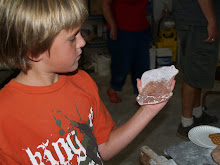More on the Swallows...
Behavior This is what we have to look forward too. : )
This is what we have to look forward too. : )
Barn Swallow chicks waiting to be fedhttp://en.wikipedia.org/wiki/Hirundinidae
Swallows are
excellent
fliers, and use these skills to attract a mate and to defend
territory. In
general, the males select a nest site, and then attract a
female using song and
flight, and guard their territory. The size of the
territory varies depending on
the species of swallow; in colonial-nesting
species it tends to be small, but it
may be much larger for solitary
nesters. The air speed of a fairly typical
unladen European swallow is
estimated to be roughly 24 miles per hour.[1]
Pairs of mated swallows are
monogamous,[2] and pairs of non-migratory species often stay
near their breeding area all year, though the nest site is defended most
vigorously during the breeding season. Migratory species often return to the
same breeding area each year, and may select same nest site if they were
previously successful in that location. First-year breeders generally select a nesting site
close to where they were born and raised.[3]
Most species
hunt over open country or near water.
Swallows are able to produce many
different calls or songs, which are used to express excitement, to
communicate
with others of the same species, during courtship, or as an
alarm when a
predator is in the area. Begging calls are used by the young
when soliciting
food from their parents. The typical song of swallows is a
simple, sometimes
musical twittering.








No comments:
Post a Comment